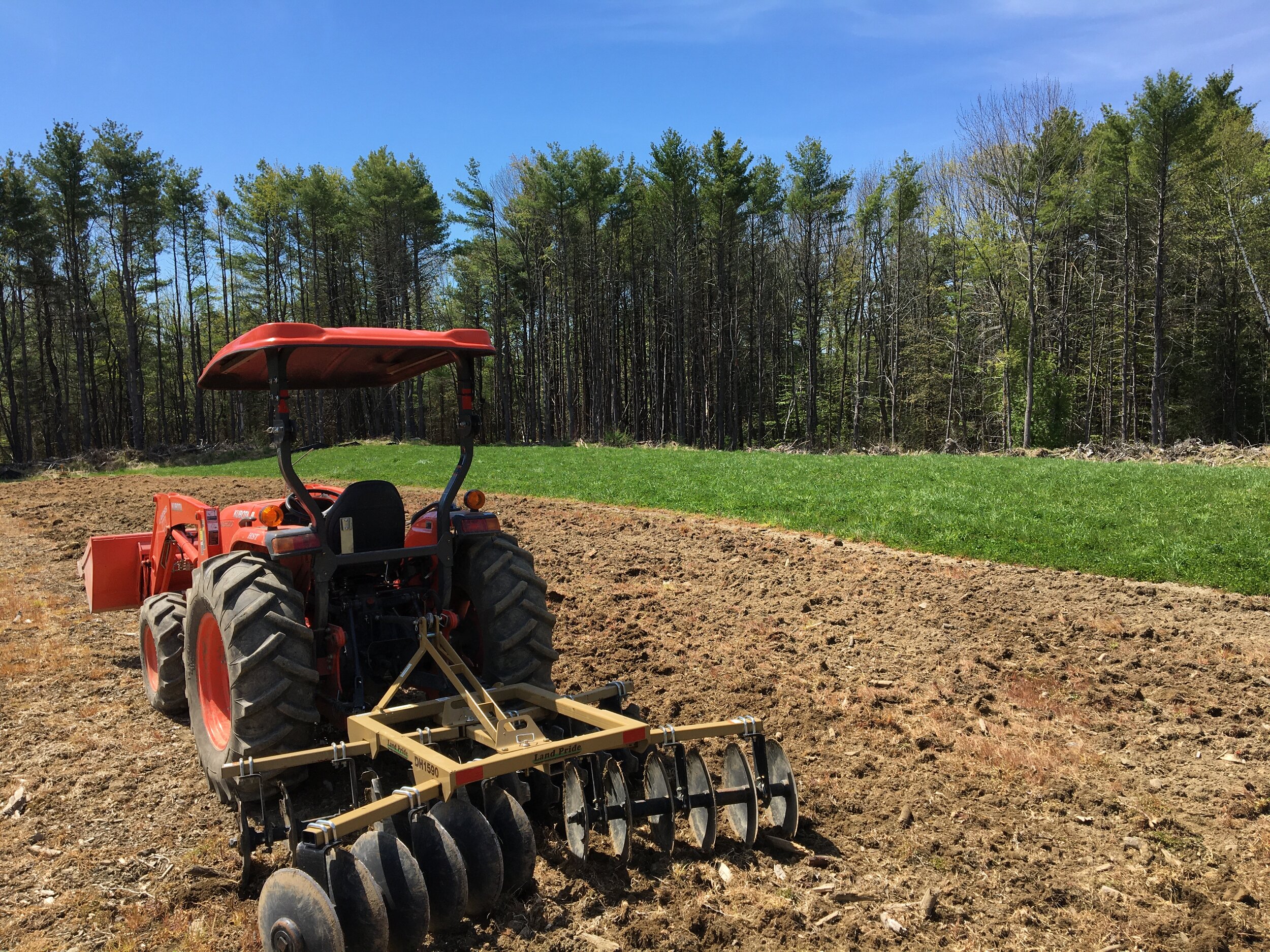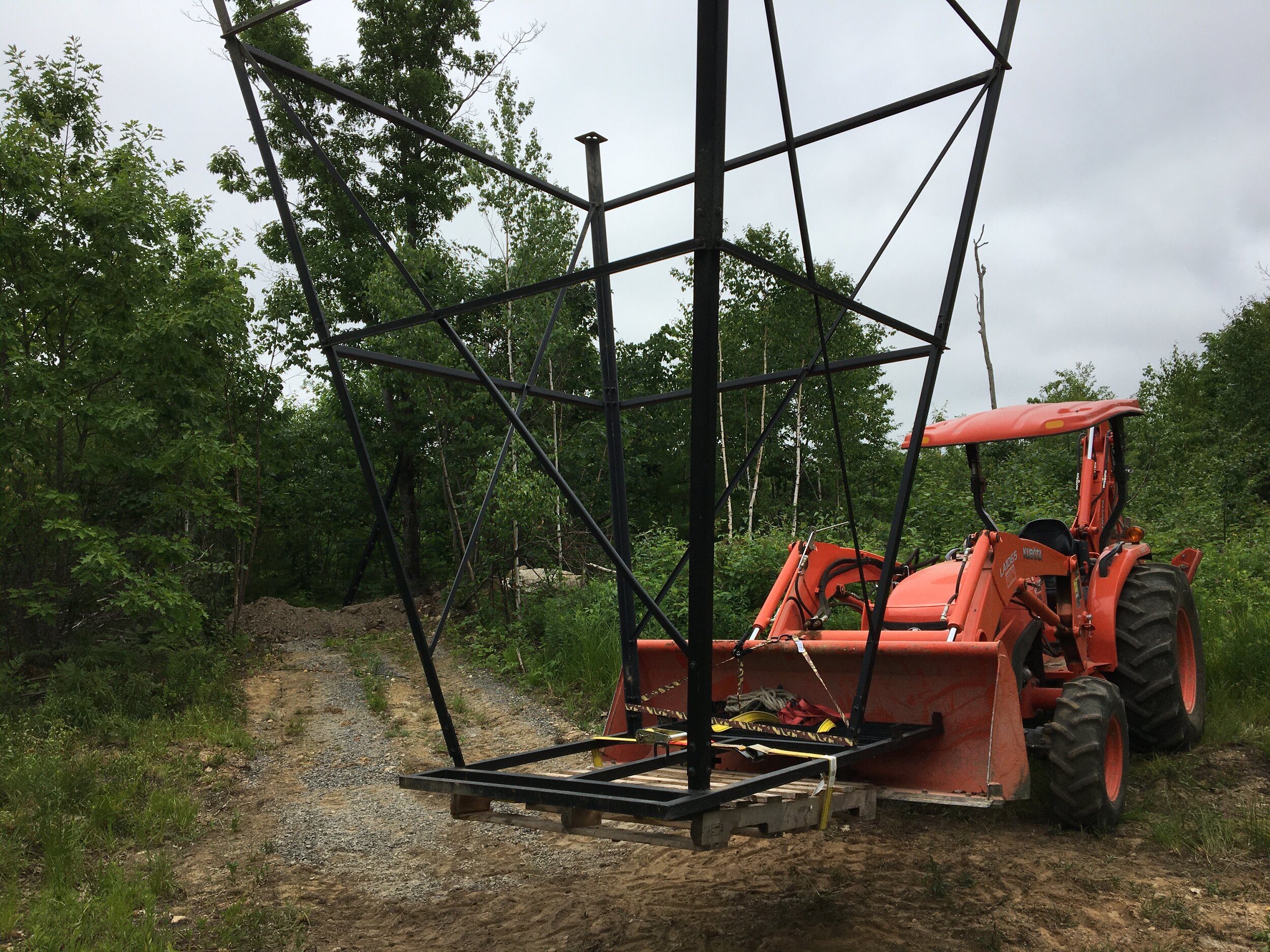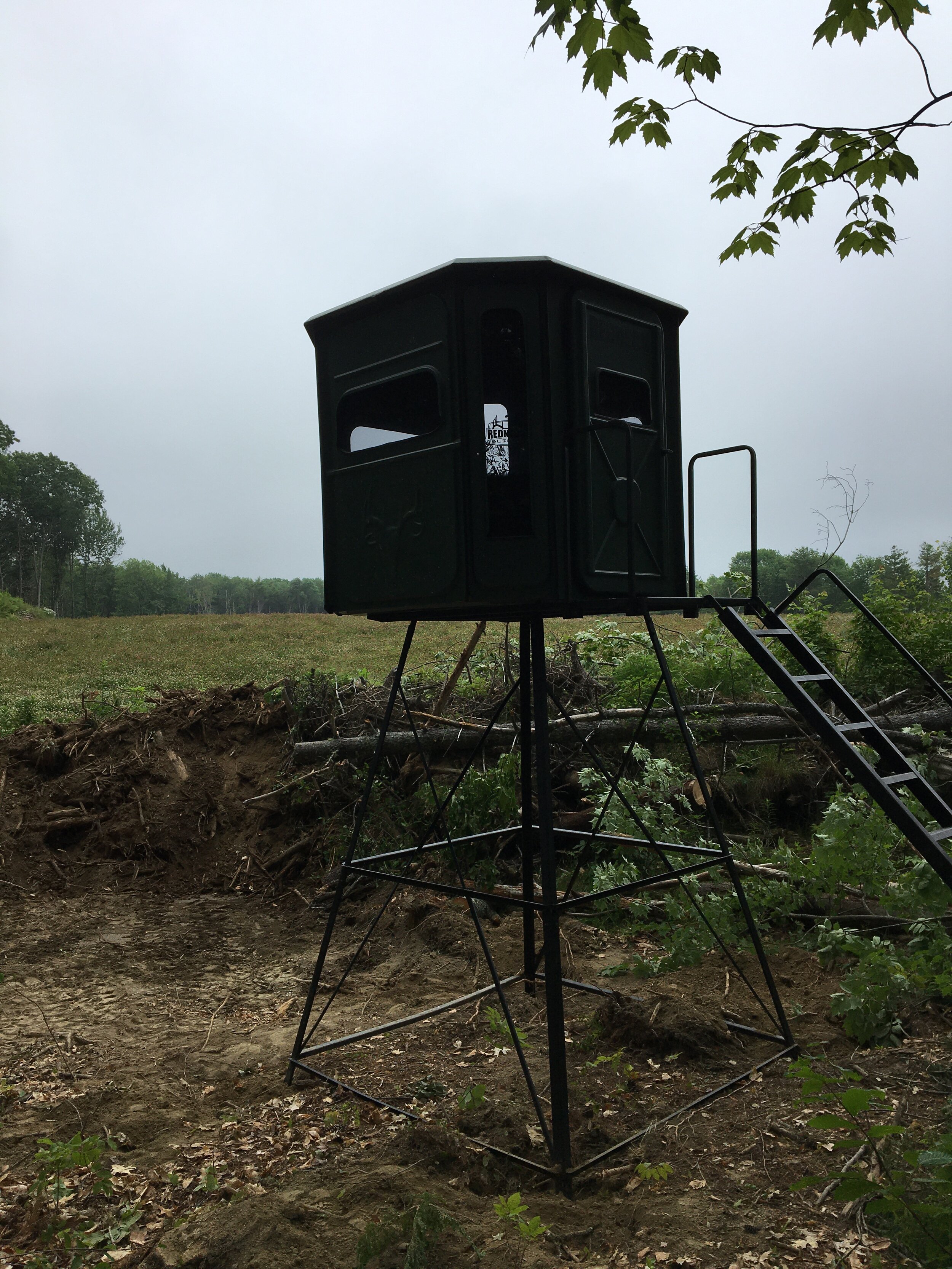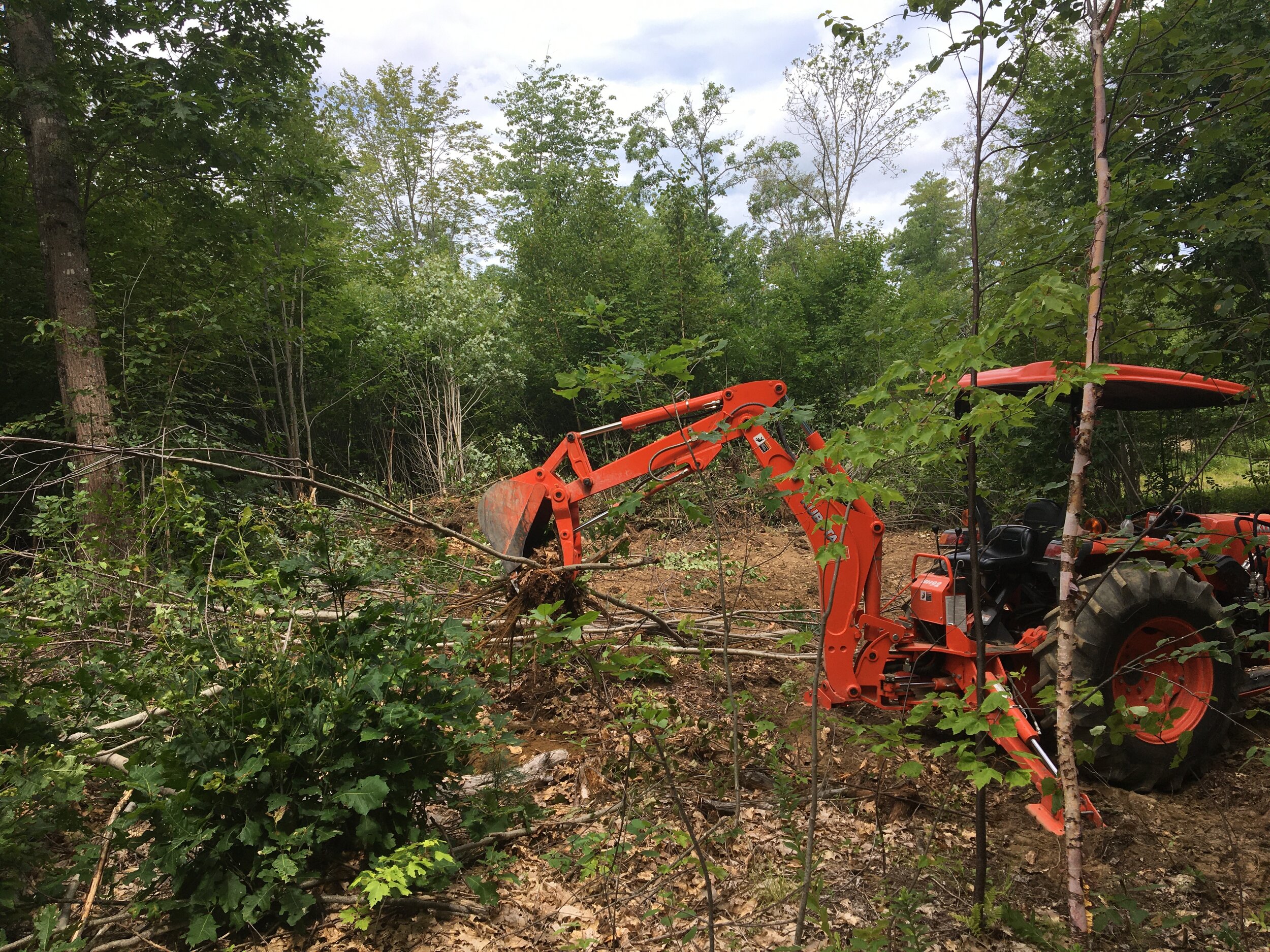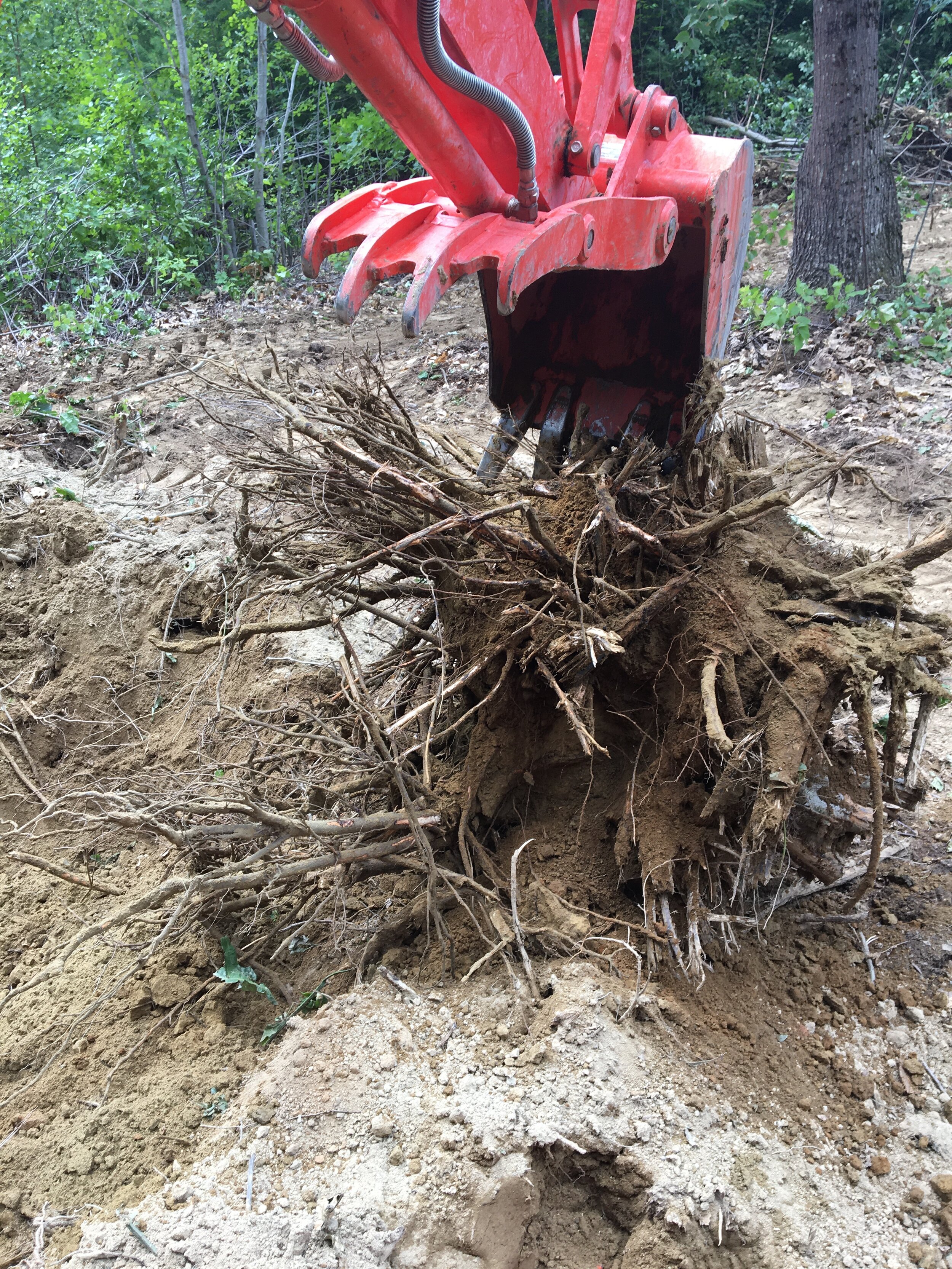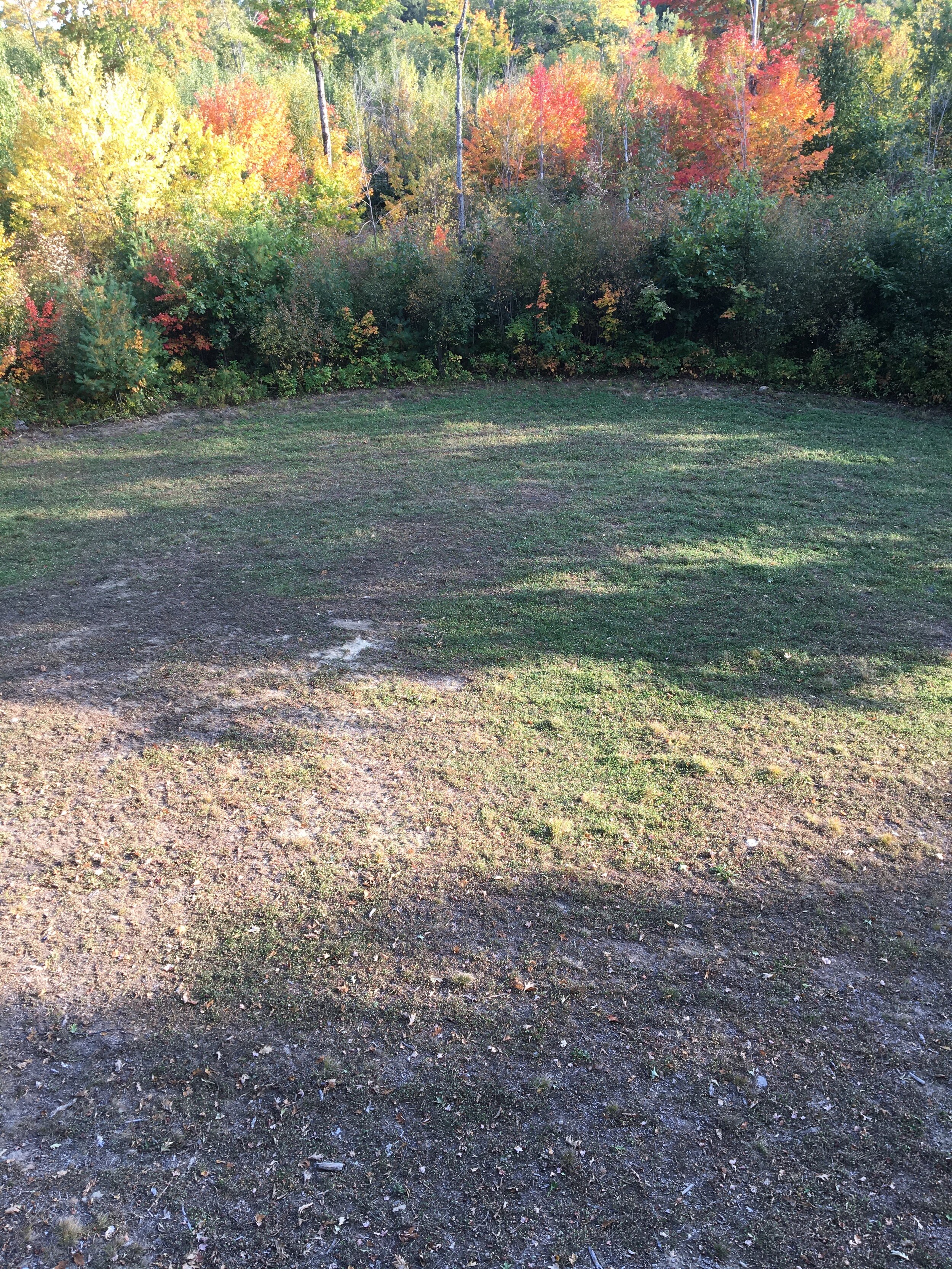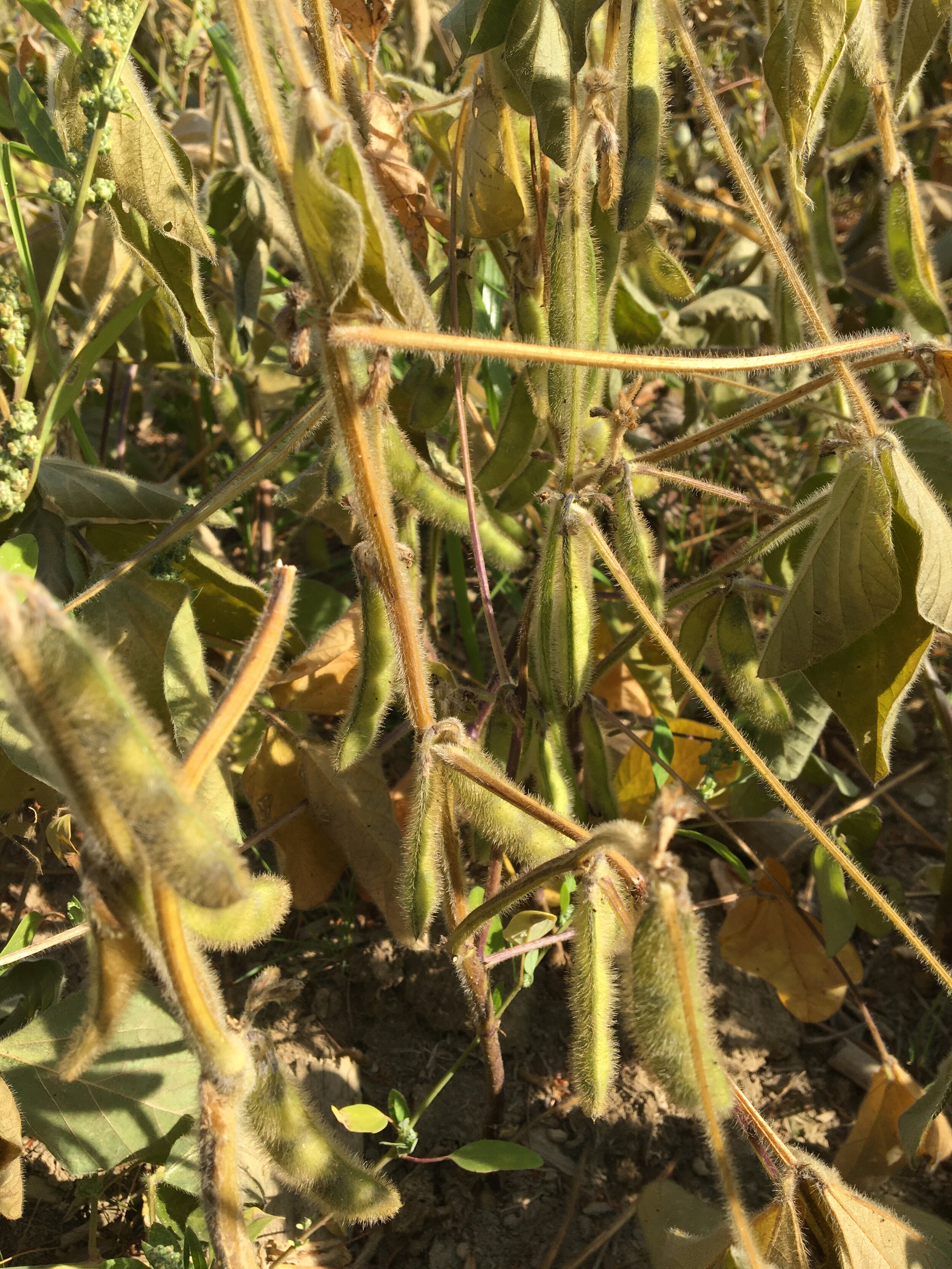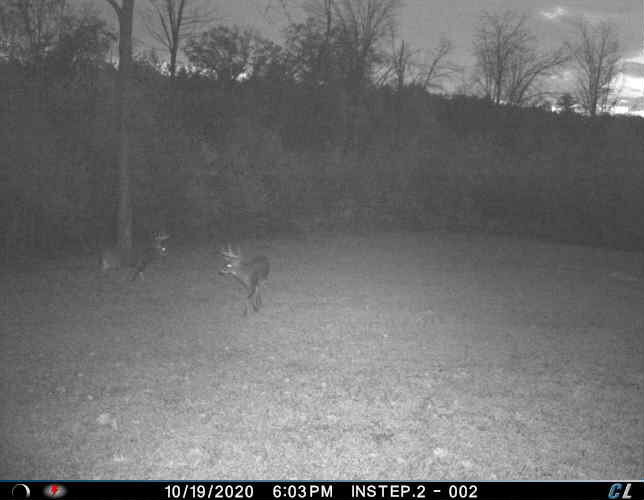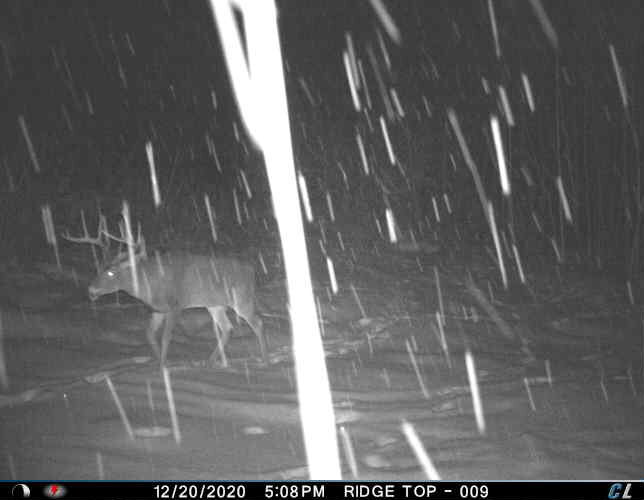2020 Land Management Case Study
The 2020 plan was, once again, ambitious
The 2020 plan picked up where 2019 left off, continuing with unfinished projects from the previous year, and adding to them.
I would need to finish spreading gravel on the tractor road to improve the sections that I hadn’t finished in 2019, including a new culvert at the Lightning plot.
The Big Field is about seven acres in total, divided into six food plots that are each an acre to an acre and a half. I have been planting two of the plots with annuals each year, and the other plots are perennial clover or alfalfa. In addition to the two plots in Big Field, I also planned to replant Barn, Ledges, and Pond, and then build a new plot running just south of Lightning. I wanted to try soybeans in the Big Field, perennial clover in Barn and Ledges, and the fall Beets & Greens mix in Pond and the new plot. Beets & Greens had been the most attractive fall mix I tried in 2019.
In 2019 I put up a Redneck Buck Palace at the trail junction at the top of the ridge, didn’t get many bucks on camera, and never hunted it - I planned to move that blind to cover an entrance trail at the west end of the Big Field. The blind will allow me to hunt that high traffic area and not worry about my scent blowing toward the South Entrance or out into the Big Field.
I planned to expand the area of the Lightning plot, adding forage toward the south to get it closer to a tree stand located at the “heel” of the boot-shaped original 61 acres. A lower priority would be to put in a new food plot just south of the barn, next to an established bedding area, hinge-cut barriers in that area, and put up a tree stand.
Using half of a 40 foot extension ladder as a safe and permanent tree stand ladder
At the northeast corner of the Big Field is a gap where I’ve seen many deer enter and exit the field, including bucks. I wanted to locate a tree stand there, hidden in a grove of mature oak trees near the gap. Deer feed in fields at night, so when I have a stand location that’s within sight of a large food plot I like to use a hang-on stand rather than a ladder stand. The hang-on allows the hunter to go up and down the back side of the tree, using the tree itself to block the deer from seeing the hunter when climbing or exiting the stand.
In 2019 I started buying aluminum extension ladders on Craig’s List. One 40 foot ladder can be separated into two 20 foot ladders and, if you remove all the hardware and secure it to the tree, you have two safe, affordable, quiet, and indestructible ladders for your tree stands. The only downside with the ladder halves is the need to climb carefully so as not to hit them with anything to make a noise - they don’t rattle or creak, but you have to climb slowly. My climbing sticks tend to make squeaking and creaking noises when I climb, alerting any deer bedded nearby, so I will replace them with aluminum ladders wherever possible.
In the fall and over the winter I had been thinking about a large piece of central Maine land for sale several towns to the north. 678 acres that looked great online and was offered for a reasonable price. My goal would be to manage the trees for carbon storage, and have a great place to gun-hunt with friends - it wasn’t located in one of Maine’s Expanded Archery Zones, but I already had good bowhunting land. I planned to contact the listing broker in May to walk the land.
It’s hard to drop the bigger trees right where you want them
COVID-19 and hot weather made us flee Florida early in 2020. We got home to Maine in late April, a week or two earlier than normal, and I immediately got back to work. I started in on the tractor road, spreading gravel, replacing an undersized culvert, and adding another. The spring had been dry, so the ground would be workable soon for the spring planting. I also had some hinge-cuts barriers that I wanted to make.
Hinge-cutting trees to form a living barrier is hard work, so I like to get it done while the weather is still cool. On the 2020 plan the hinge-cuts are marked in orange - I decided to start on the cut in the middle of the property that runs horizontally. On the west end of the barrier is the Pond food plot, and the barrier would run east to the corner of the new food plot just south of the Lightning plot - that new plot would be called Grove. Making a barrier here should cause the deer to walk around it on both ends to stop for a bite to eat at either Pond or Grove, hopefully in range of the tree stands. The trees to be cut for the barrier were larger, and that would mean two things: I would cut them with a chainsaw, and extra effort would be needed to get them to fall in the right spot. The work went well, though one spot needed some deer fencing to fill in a gap in the trees.
With the weather still cool, I kept going with my hinge-cuts. I made a barrier to the north of the Instep plot that would make it harder for deer to feed on the acorns behind that stand without first walking through the plot. I also hinge-cut barriers around the Ledges plot and the Garden that would make it harder for deer to sneak past those stands. All of this work was done using small diameter trees and a handsaw - harder physical labor, but easier to get the right results.
To prep for soybeans I sprayed then disked
I wanted to move a Redneck box blind from the top of Buck Ridge to the northwest corner of the Big Field, and put up a new stand in the northeast corner of the Big Field. Both those areas would require extensive hinge-cut barriers to direct the deer past the blind and the stand. Those were also where the trees were bigger and a chainsaw would be needed. When I clearcut the Big Field I had the loggers leave a few rows of pines along the edges so I could hinge-cut them for barriers - a simple concept, but hard to execute. This is hot, sweaty work requiring chaps and a helmet, as well as wedges and a hammer to direct the trees that didn’t want to cooperate.
It can be frustrating if the trees don’t fall where you need them, if they get hung-up on another tree, if the wedges don’t change the direction of the tree, or the chainsaw gets stuck. Planning is important, and having an extra chainsaw is occasionally necessary. The barrier running south of the new box blind location went fairly well, but the work on the northeast corner was harder due to fewer trees available. When one tree gets hung up or doesn’t fall in the right spot, you have to drop-back for another tree and try again. If you leave a gap, the deer will find it and move past you out of range or bust you from downwind. With a lot of planning, cutting, revised planning, and wedge work I got it done.
Agricultural lime in bulk is the best deal
I had two acres in the Big Field I wanted to plant with an annual crop, and I was looking for something different. I always hear that in the midwest soybeans are absolutely the best crop for attracting deer, but the problem is that they love them too much and eat them down to the dirt. You can’t plant a small plot of soybeans or they will be devoured before the hunting season. I’d never heard of anyone near me growing soybeans, but I loved the idea of a crop that the deer would crave more than anything else. I couldn’t imagine that I had so many deer that they would destroy two acres of beans, so I decided to give it a try.
I needed to do soil tests on all of my plots - some would need regular maintenance doses of lime and fertilizer, and several would be planted again this year. Newly cleared plots, like Grove, could get away with using the soil test results from the new plots I’d done in the past. The big field is broken into six plots that are all an acre or more in size. I did one soil test for the two acres of soybeans, and then one test for the remaining four plots, plus the other plots elsewhere on the land. It was a total of eight tests.
Tower moving day
I made a bulk purchase of the various fertilizer blends I needed from Northeast Ag, and called Ken Irving to schedule him to spread lime. I’d always been able to get his truck into the Big Field, but now I had improved my central tractor road to the point that he could access most of the food plots on the original land. As I’ve said before, using a commercial bulk lime spreading truck is absolutely the only way to go!
To prepare for the spring planting I sprayed the plots with generic glyphosate to kill all the vegetation, following up with a disk harrow a couple weeks later. Some plots still hadn’t dried out from the winter and were too wet to work, so they would have to wait. We also weren’t getting much rain in the spring of 2020, so I needed to wait for that to change. Soybeans should be planted around the time that you would plant your vegetable garden, which is traditionally Memorial Day in central Maine, but like any food plot crop, you also need to have some rain in the forecast.
New location: NW corner blind
While I waited for rain, I continued with my other projects. I relocated a ladder stand at the South Entrance to a tree with better cover. I put the new tree stand up in the northeast corner, and cut an access trail to allow me to get in and out without being seen. And my son helped me move the box blind from the trail junction at the top of Buck Ridge, down to the northwest corner of the Big Field. I had located the blind at the top of the ridge because I had two shooters on camera there in 2018 and I was concerned that a tree stand wouldn’t give me enough cover to draw a bow. The blind must have spooked the deer because they didn’t come back in 2019. The Big Field always had action and the box blind would enable me to get into the thick of it. After we moved the blind, I located a ladder stand at the top of the ridge and hoped that things would work out if the bucks came back and I got a shot opportunity from that stand.
At the end of June we finally had some rain in the forecast, so my thoughts turned back to soybeans. The conventional way for farmers to plant soybeans is to use a grain drill. This is a tractor attachment that uses disks to pull the soil apart and drop a seed in at the desired depth and rate. They are expensive and I didn’t want to buy one to just use once a year, so I researched other methods of planting soybeans. I decided to try the method I’d used for other large seeds, like oats, which is to broadcast the seeds with my spreader, then run the disk harrow over the field with the disks set straight. This will cause a high percentage of the seeds to be at the right depth for good germination and growing.
Once the deer figured out they could eat the soybeans …
I planted in late June and rode a window of rain into July that allowed my beans to get established before Maine went back into drought. Soybeans have a deep root system and the planting did ok during the drought, though maybe a bit stunted. They managed to look healthy all summer and into the fall, supplying lush green food for the deer and growing pods. At first I was concerned because they looked good to me, yet the deer weren’t touching them. But after several weeks I noticed patches of browsing, and then they began to get hammered - the deer had never seen a soybean, so it took time for them to learn that they could eat them!
All summer and into the September Maine Expanded Archery hunting season I had a herd of deer in the soybeans every evening. After a very early frost hit them in September, I was bummed because they immediately turned brown and died, but the deer figured out that the beans inside the pods were tasty and kept eating them. I had a greater number of deer than usual in the Big Field every night from opening day throughout the entire hunting season, and into the depths of winter.
Starting on the new Grove plot
Deer ate the leaves of the soybeans while they were green, but not enough to kill the plants or keep them from forming pods, and then they kept eating the beans in the pods throughout the fall. And flocks of turkeys loved them too. As I was putting my land to bed for the winter I opened a pod and ate a couple dried beans. They were good! I personally wouldn’t want to survive the winter eating nothing but raw soybeans but, compared to anything else you might try to nibble on in the deer world, they were quite good. I will be planting beans again, and I’m wondering how much better they will do with adequate levels of rain. The soybeans were a tremendous success - the best food plot ever!
A smallish oak stump
Ok, so the two acres of soybeans in the Big Field were a success, but I also had four smaller food plots scattered around the 108 acres that had been planted in annuals in 2019, and they all needed to be replanted. I wanted to reduce the fall planting workload in the future, so I planned to plant perennial clover in Barn and Ledges. A seed mix called Beets & Greens had been the most attractive fall planting I tried in 2019, so I would plant that in Pond, the east end of Big Clover, and in the new plots I cleared.
The summer was hot and dry, turning into a drought that wouldn’t break until late fall. The soybeans had caught a window of rain that enabled their deep root systems to get established before Central Maine went back into drought. Twice during the spring and summer there was rain in the forecast and I tried planting clover and the fall Beets & Greens mix, but the drought came back and the plots suffered.
Looking south at Grove, the finished product
In late July I started to grub-out the new plot just south of Lightning. It’s about 100 yards long and I named it Grove because of the few oaks and maples I left standing. I put the backhoe attachment on the tractor and started grubbing. The routine is to back into place, climb into the backhoe seat, and rip out as much as you can reach. Then get back in the tractor seat, reposition, and repeat the process. Softwoods were easy, as were the birch, aspen and ash because they were single trees that probably grew from seed. The maple stumps were a little tougher because they had sprouted from stumps, but usually I could get them out in one go.
The real problem were the oak stumps. These small oak trees had grown from the stumps of logged trees, often large stumps with many trunks that had grown from the same stump, and in some cases the growth of two stumps next to each other had knitted together into one mass. The root systems were deeper and wider than the maple trees, and they didn’t want to come out. I often had to reposition multiple times, in a circle around the stump system, digging a huge hole before I could get the root ball to loosen.
Like most of the original 61 acres, the spot I chose for the Grove plot had been a thick mess of hardwood regeneration, but the land was flat and the soil looked good. I have an aerial photograph of this land from the 1940s and the Grove was once part of a pasture. The land running from Grove toward the west is now five or more acres of thick bedding. As I grubbed the stumps and vegetation out I pushed it all off to the west side, forming a gnarly berm that would be hard for a deer to get through. The path of least resistance for a deer going to and from the bedding area would be to walk around either end of the berm - right past the stands at either Grove or Lightning.
Drought: Instep is usually a lush clover plot!
After grubbing out the trees and bushes, I used the disk harrow to loosen the soil, and then smoothed it with the landscape rake. The seedbed was now ready for lime, fertilizer, and seed. Lime takes months to neutralize the soil, but it was already mid August and I needed to get something growing if possible. I finished with the Grove plot by planting Beets & Greens and hoping that the drought would end and we’d get some much needed rain.
But the drought didn’t end until after the growing season was over. I planted the Barn and Ledges plots twice, but neither planting produced a healthy plot. The east end of Big Clover had an ok crop of clover that had sprouted from seeds in the cow manure I spread in 2019, so I elected to leave it be. I planted Pond and Grove in Beets & Greens - Grove ended the growing season with a couple patches of vegetation, and Pond grew a good crop of something that looked like grass. Judging by the trail cam photos, deer didn’t seem to be attracted to either of these newly planted plots.
The established perennial plots varied in forage health depending on the quality of their soil. Big Clover and Instep have poor quality soil with low amounts of organic material, so they tended to burn out easier in the drought. Deer fed in them, but the browse declined in quality as the season wore on. The Garden plot is right next to the barn, and in 2019 I had spread a large amount of cow manure on it - in 2020 it was a shining star, filled with lush clover and regularly getting hammered by a group of five does.
The Big Field had two acres of soybeans, but it also had 4-5 acres of perennial clover and alfalfa. The drought hurt the perennials, but the soil is good and they were in fairly good shape considering the stress they were under. Deer loved the soybeans, but they grazed on the perennials as well, thriving on the variety of forage.
Harvey Wallhanger beds somewhere along Buck Ridge
I had 15 cameras located around the 108 acres, and had converted all of them to solar power - every morning I checked my email for the photos from the previous 24 hours. I got a feeling for where the deer were moving, which food plots were attracting them, and I also started to see a variety of bucks living on the land. In 2018 I didn’t shoot my first deer until mid-October and, because I wanted meat in the freezer, my first harvested deer was a yearling buck. A buck is never going to have a great set of antlers if you shoot him when he’s young, so I swore I wouldn’t do that again. When the season started in 2020 I was thinking that 2 1/2 years old would be the youngest buck I would shoot, and I might even pass on that age class if I knew that I had older bucks on my land.
I had seen a couple trophy bucks on camera in 2019, so it wasn’t a total surprise when I started to see some really nice bucks in 2020. It looked like one of the bucks from 2019 had survived and was now at least 4 1/2 years old - I guesstimated that he might score close to 150 inches. I named him Harvey Wallhanger. Another buck was close in age, but had a smaller six-point rack and no brow tines - I called him the No-Brow Six. And one more deer was a shooter - a nice eight-point that was at least 3 1/2 years old, that I named the Big Eight.
No-Brow Six is a mature big-bodied deer
In 2019 I had group of three bucks walk past me at the Instep plot, one of which was a trophy, but I couldn’t take the shot due to a wardrobe malfunction (read about it in last year’s land management update, if you must). Could it be that this year’s three shooters are the same trio as last year? Hunters on TV always talk about naming and following the same bucks for years before shooting them, but I have a hard time recognizing a buck from one year to the next. Their antlers just don’t seem to be that distinctive, and trail cam photos often don’t show the entire rack. It’s challenging enough to keep track of bucks during one season! Maybe those TV personalities are stretching the truth to make a better story? Oh, how cynical of me!
In 2020 I was seeing two or three yearling bucks with spike or fork-horn racks, and a pair of 2 1/2 year bucks. Harvey was elusive, only showing occasionally on camera at the top of Buck Ridge, or over at the western end of the ridge at the Instep plot. No-Brow Six and the Big Eight hung together often, but No-Brow Six was the home-body that I regularly saw on camera.
The No-Brow Six leaving the soybeans
To refresh your memory, in the Maine Expanded Archery zones you can shoot two bucks and as many does as you want to buy tags for. With three bucks that were true trophies, I was planning to hold my buck tags for them, and pass on the younger bucks. Of course I would gladly shoot a doe because I like venison and the deer population was skewed to the female side. A more balanced buck/doe ratio results in better hunting during the rut because bucks need to travel more during the day to find breeding partners. Unfortunately Maine hunting laws allow firearms hunting throughout the rut, putting a lot of pressure on young bucks, and the result is an unbalanced buck/doe ratio and a more subdued rut.
The Maine Expanded Archery season started September 12th. My strategy every year is to hunt conservatively at first, meaning my goal would be to focus on locations where I could get in and out without spooking any deer. I almost always hunt afternoons because I don’t want to jump deer getting to my stand - I also don’t love getting up super early in the morning unless it’s worth it. The first goal would be to get meat in the freezer, so I’d hunt areas where I’ve been seeing both bucks and does on camera, and shoot the first doe or mature buck that gives me a shot.
The Big Eight following just a minute later
The Garden plot right next to the barn regularly had does coming in to feed before dark, but on opening day the wind was wrong for that plot so I hunted the relocated box blind at the Big Field. I had cut and raked a path through the woods to get to the blind, but that first time I figured it would be easier to walk in along the very edge of the field - I had never seen deer feeding along that edge. Well, wouldn’t you know, three does came in along the edge of the field, and the big one smelled my tracks. She spent minutes stomping back and forth, and then they all ran off. One of my shooters came into the filed to eat soybeans, but he never came down to my corner. A young 8-point in full velvet walked past the blind, but I passed on him because the older trophy buck was still in sight. An awesome opening day with about a dozen deer sighted!
On the 16th the wind was right and I hunted the Garden plot, but no deer came in. On September 19th I was hunting the Lightning stand when a doe walked out below me. She looked very small, and I kept thinking that I really didn’t want to take her because she was so small. I was relieved when she managed to make it through the food plot without ever giving me a shot - I doubt she would have weighed 70 lbs. Not long afterward a nice doe followed her trail, pausing quartering-away at 25 yards, and I sent an arrow through the boiler room. I recovered her less than 100 yards away in the thick cover - a 100 lb. doe for the freezer.
Soybeans in their pods after the killing frost
With one deer at the butcher, I changed my hunting strategy to focus on the bucks. I now ignored spots that mostly drew does, like the Garden plot, and carefully hunted the spots that I knew the bucks were frequenting. The drought was a problem because many of my smaller “harvest” food plots weren’t offering much forage, and a good crop of acorns was drawing deer off of my property. I have good bedding cover for deer, but I want the small plots to be their first stop when traveling from their bed to nighttime feeding spots.
On October 5th I had a photo of two shooters walking past the box blind on the east end of the Big Clover plot the previous afternoon, so I went in there for the afternoon hunt. Deer came into the field from the far side at the end of the day - three were bucks, including one shooter. They slowly fed their way east toward me, but hung up at about 60 yards as it got dark. I waited until I could barely see them and then coyote howled out the back window to scare them away. I assume they left before they could see me climbing down from the blind, but it was a very dark night.
When you are hunting from a tree stand over a small harvest plot and there are deer feeding as it gets dark, they usually leave on their own for their next food source. Sometimes you can lower your bow and move it around in the leaves on the ground and that will scare them off, but you don’t want to educate them by letting them see you climb down.
Harvey runs down to the Garden to pester the girls - a true trophy!
The problem with leaving a larger destination plot like Big Clover and Big Field is that the deer are usually still browsing when it gets dark - they’re more comfortable there. Later in the season I tried the coyote howl trick from the relocated box blind when that same older doe was in the Big Field, but she still remembered smelling my tracks weeks before and knew something was fishy. I howled and barked, making an ear splitting noise as loud as I could, but she wasn’t buying it. Finally she and her girls trotted off to the east, noses held high, probably out of boredom. I’m thinking that I should get a remote control predator call next season - press the button and spook the deer off the food plot - retain my dignity.
I caught a photo of Harvey in the Barn plot at night on October 6th so, when the weather was right a couple days later, I hunted the new ladder stand at the top of the ridge in hopes of catching him coming off the ridge in daylight. Just before dark I saw a blur in the woods in front of my stand and, as I was reaching for my bow, Harvey popped-out into the trail at 30 yards, staring right at me. I froze, and he stared. He either thought he saw movement, or he was wondering what the hell the blob was up in that tree. After a long pause, he gave a relaxed flick of his tail, turned, and vanished before I could do anything. I saw on my Garden camera that he had galloped a couple hundred yards down to that plot and checked-out the does feeding there. The new stand was in a good place, but next year I would need to hinge cut some trees to direct the deer closer to the stand, and also put up something to give me cover behind the stand.
Would’a … could’a … should’a … two shooters at 20 yards … argh!
October 19th rolled around and the bucks were still not showing signs of rut behavior. The wind was out of the south, so I rode my e-bike to the west of my land and walked in to the Instep plot. The afternoon was free of deer, and as it started to get dark I began to pack up to leave. Just then I noticed two large bucks enter the food plot from the east. I buckled my trigger release back on my right wrist, carefully grabbed the bow off the holder, and hooked my release to the D-loop. I must have made some noise because one of the bucks stayed back looking around, but the other walked right into the plot and began to feed. Just 20 yards right in front of me, broadside.
In the approaching dark I couldn’t see his antlers clear enough to positively identify him. He was silhouetted against the light green clover in the plot, so I could easily see his mature bulky body and thick neck. He was definitely a shooter, but I was wondering which deer he was. Was he the bigger of the two deer? I hesitated, as the other buck started to get nervous, and I looked from one deer to the other. The closer buck was still head-down and broadside to me, at less than 20 yards, feeding on the clover. I could still see my pins, it was still legal shooting time, he was at a chip-shot distance, and yet I decided to pass. The trail camera photo from that night shows that No-Brow Six and The Big Eight came into the plot. I am still kicking myself for the decision to not take the shot. I got hung-up on not knowing which deer he was, and figuring that I’d get another chance later in the season. Argh!
A good crop of does coming out of Big Field
The rest of the season passed without me getting another chance at one of the big bucks. I passed on a mature doe who, along with a younger doe and a fawn, fed in front of me at the Ledges plot at 10 yards. I took my climber into the woods behind the Garden plot and passed when two young twin bucks fed on acorns beneath my stand. I passed on one of the 2 1/2 year old bucks at 30 yards in the soybeans. And I had another blowing and stomping standoff with that obnoxious old doe in the Big Field - she didn’t give me a shot, or I would have definitely taken her out of the game.
I ended up buying the 678 acres of land located a few towns to the north, and also bought another 43 acres located right next to it. To help me cut some ATV trails for access into the land, I bought a tracked skid steer and put a forestry mulcher on it. I also spent some time exploring the land - bringing my rifle along in case a buck showed himself. The new land had large rubs and scrapes, as well as droppings so large that they could only come from a mature buck.
Harvey continued to make an occasional appearance after the season
2020 was the best hunting season yet for this land management project, though the drought limited the attractiveness of many food plots. The improvements to food and cover were showing results as I had multiple doe family groups, some young up-and-coming bucks, and three resident shooters. I stopped doing any major improvements in September, so the land had been quieter in the fall of 2020 than ever before - that probably made the three shooters more comfortable bedding on my land.
During the last half of the season I was holding out for a mature buck - making the decision that one doe in the freezer was enough if the buck didn’t materialize. Next year I will probably harvest an additional doe if given the chance - I’m not sure that the venison from just one deer will be enough.
After the season ended I continued to get some mature bucks on the 13 solar-powered trail cameras that I left deployed across the 108 acres. Deer kept coming to the Big Field, so the soybeans were a draw during the post-season. Harvey Wallhanger continued to make appearances, as did the two 2 1/2 year old bucks - it looks like I will continue to have a crop of shooter bucks in 2021.
To keep reading about my land management project: Click Here To Go Forward To 2021
To go back to the previous page, Click Here To Return To 2019.



